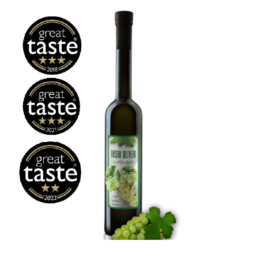Description
The Fruit:
Bunches of small, glossy black fruit develop along the stems in the summer and can be harvested by hand or by machine.Blackcurrant palinka will linger longer in your memory.Traditional pot-still method only from ripe and clean fruit.Intensive smell, distinctive, spicy and sweet.
The Medicine:
The fruit is rich in vitamin C, various other nutrients, phytochemicals and antioxidants.The fruit and foliage have uses in traditional medicine.
The Uses:
Blackcurrants can be eaten raw but are usually cooked in a variety of sweet or savoury dishes. They are used to make jams, jellies and syrups and are grown commercially for the juice market. The fruit is also used in the preparation of alcoholic beverages and both fruit and foliage have uses in traditional medicine and the preparation of dyes.Blackcurrant stains linger forever in clothes.The fruit of blackcurrants can be eaten raw, but it has a strong, tart flavour. It can be made into jams¬†and jellies which set readily because of the fruit’s high content of pectin¬†and acid.For culinary use, the fruit is usually cooked with sugar to produce a puree, which can then be passed through muslin¬†to separate the juice. The puree can be used to make blackcurrant preserves and be included in cheesecakes, yogurt,¬†ice-cream,¬†desserts,¬†sorbets¬†and many other sweet dishes. The exceptionally strong flavour can be moderated by combining it with other fruits, such as raspberries and strawberries in summer pudding or apples in crumbles and pies.¬†The juice can be used in syrups and cordials.
The Story:
The blackcurrant is native to northern Europe and Asia. It was cultivated in Russia by the 11th century when it was present in monastery gardens and also grown in towns and settlements. Cultivation in Europe is thought to have started around the last decades of the 17th century.¬†Decoction¬†of the leaves, bark or roots was also used as traditional remedies.During World War II , most fruits rich in vitamin C , such as oranges , became difficult to obtain in the United Kingdom. Since blackcurrant berries are a rich source of the vitamin and blackcurrant plants are suitable for growing in the UK climate, the British Government encouraged their cultivation and soon the yield of the nation’s crop increased significantly. From 1942 on wards, blackcurrant syrup was distributed free of charge to children under the age of two, and this may have given rise to the lasting popularity of blackcurrant as a flavouring in Britain.







Reviews
There are no reviews yet.